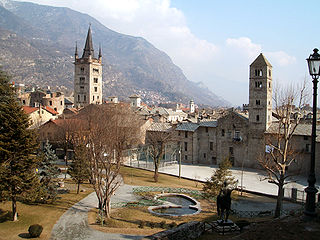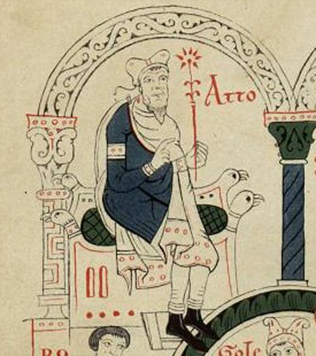
Avigliana is a town and comune (municipality) in the Metropolitan City of Turin in the Piedmont region or Italy, with 12,129 inhabitants as of January 1, 2023. It lies about 25 kilometres (16 mi) west of Turin in the Susa valley, on the highway going from Turin to Modane, France.

Susa is a town and comune in the Metropolitan City of Turin, Piedmont, Italy. In the middle of Susa Valley, it is situated on at the confluence of the Cenischia with the Dora Riparia, a tributary of the Po River, at the foot of the Cottian Alps, 51 km (32 mi) west of Turin.

The Susa Valley is a valley in the Metropolitan City of Turin, Piedmont region of northern Italy, located between the Graian Alps in the north and the Cottian Alps in the south. It is one of the longest valleys of the Italian Alps. It extends over 50 kilometres (31 mi) in an east-west direction from the French border to the outskirts of Turin. The valley takes its name from the city of Susa which lies in the valley. The Dora Riparia river, a tributary of the Po, flows through the valley.

Sauze d'Oulx is a town and comune in the Metropolitan City of Turin, Piedmont located 80 km from Turin in the Val di Susa, at the foot of Monte Genevris.

Walter or Walther of Aquitaine is a king of the Visigoths in Germanic heroic legend.

Susa Cathedral is a Catholic cathedral in Susa, Piedmont, in northern Italy. It is the seat of the Bishop of Susa and is dedicated to Saint Justus of Novalesa.

Adalbert Atto was the first Count of Canossa and founder of that noble house which eventually was to play a determinant role in the political settling of Regnum Italicum and the Investiture Controversy in the eleventh and twelfth centuries.
Ulric Manfred II or Manfred Ulric was the count of Turin and marquis of Susa in the early 11th century. He was the last male margrave from the Arduinid dynasty. Ulric Manfred's daughter, Adelaide, inherited the majority of his property. Through marriage to Adelaide, Otto of Savoy, a younger son of Count Humbert I of Savoy became margrave of Turin. Their descendants would later comprise the House of Savoy who ruled Sardinia and Italy.
The March or Marquisate of Turin was a territory of medieval Italy from the mid-10th century, when it was established as the Arduinic March. It comprised several counties in Piedmont, including the counties of Turin, Auriate, Albenga and, probably, Ventimiglia. The confines of the march thus stretched across the Po Valley from the Western Alps in the north, to the Ligurian Sea.
Arduin Glaber was count of Auriate from c. 935, count of Turin from c. 941/942, and Margrave of Turin from c. 950/964. He placed his dynasty, the Arduinici, on a firm foundation and established the march of Turin through conquests and royal concessions. The Chronicon Novaliciense, the chronicle of the abbey of Novalesa, is the primary source for his life.
Manfred I or Maginfred was the second Arduinici marquis of Susa from 977 until his death. Manfred was the eldest son of Arduin Glaber, from whom he inherited the county of Auriate and the vast March of Susa. The march extended from the Susa Valley by the Alps south across the Po to the Ligurian Sea. Although he ruled for almost twenty-five years, there is little evidence of his activities in surviving sources. Under him, Pavia became a mercantile city. He also controlled the road between Genoa and Marseilles.

Adelaide of Turin was the countess of part of the March of Ivrea and the marchioness of Turin in Northwestern Italy from 1034 to her death. She was the last of the Arduinici. She is sometimes compared to her second cousin and close contemporary, Matilda of Tuscany.

The Sacra di San Michele, sometimes known as Saint Michael's Abbey, is a religious complex on Mount Pirchiriano, situated on the south side of the Val di Susa in the territory of the municipality of Sant'Ambrogio di Torino, in the Metropolitan City of Turin, Piedmont region of northwestern Italy. The abbey, which for much of its history was under Benedictine rule, is now entrusted to the Rosminians.

Novalesa Abbey is a Benedictine monastery in the Metropolitan City of Turin, Piedmont, Italy. It was founded in 726, and dedicated to Saint Peter and Saint Andrew.
The Arduinici were a noble Frankish family that immigrated to Italy in the early tenth century, possibly from Neustria. They were descended from and take their name after one Arduin (Hardouin).
Auriate was a county in medieval Italy on the eastern slopes of the Western Alps lying between Cuneo and Saluzzo. The county existed from the late ninth century to the middle of the tenth. The name of the county survives in that of the comune of Valloriate.
Bertha of Milan or Bertha of Luni, was a countess margravine of Turin by marriage to Ulric Manfred II of Turin, and regent in Turin and Susa for her daughter Adelaide of Susa in 1033.
The Chronica Romanorum pontificum et imperatorum ac de rebus in Apulia gestis is a 13th-century Latin prose chronicle by an anonymous monk of the monastery of Santa Maria della Ferraria in southern Italy. It is sometimes called the Ferraris Chronicle, Chronica Ferrariensis or Chronicle of Santa Maria di Ferraria. The chronicle was rediscovered in Bologna in the nineteenth century and published in English translation only in 2017.

The Exilles Fort is a fortified complex in the Susa Valley, Metropolitan City of Turin, Piedmont, northern Italy. Together with the nearby Fort of Fenestrelle and the Forte Albertino it was part of the defensive line between the House of Savoy lands and France: both these states held it in different phases depending on the outcome of the various wars. It is located on a spur commanding one of the narrowest sections of the Susa Valley, along the main road connecting Turin to France.

Avigliana Castle is one of the oldest castles in Piedmont. Now just a ruin, it is located in Avigliana at the mouth of the Susa Valley, 25 km from Turin.












